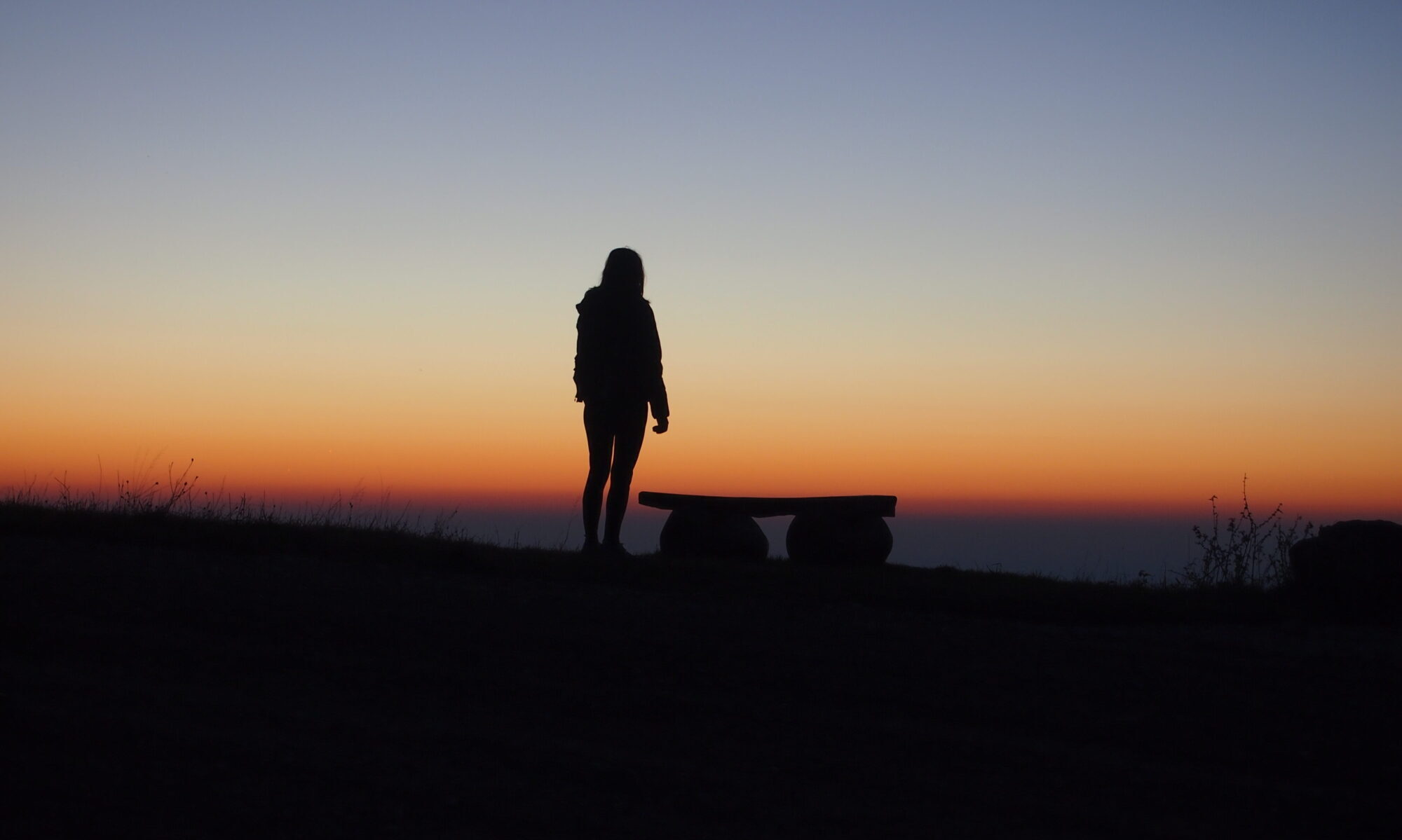E’ da un po’ di tempo che cerco di scattare qualche fermo immagine ad un esemplare di airone bianco maggiore (Ardea alba) che noto stazionare lungo le rogge e nei campi del mio Comune di residenza, Costabissara in provincia di Vicenza.
Circa un mese fa, nel mese di dicembre 2024, sono riuscito a vederlo e fotografarlo in maniera repentina in roggia Contarina e poi non ho più avuto modo di vederlo.
Incontrare questo uccello, soprattutto nella mia zona, è abbastanza raro.
Le coppie nidificanti di airone bianco maggiore presenti nel nostro territorio nazionale sono circa 600 e le aree prossime alla provincia di Vicenza dove poterlo vedere, con maggiore probabilità, sono le zone umide del Delta del Po, della laguna di Venezia, di Comacchio e Mezzano.
Generalmente gli individui di airone bianco maggiore che svernano in Italia sono provenienti da regioni del centro Europa e dei Balcani, da stati come Austria e Ungheria. Chissà da dove proviene l’esemplare che ho visto.
Giorni fa stavo per l’appunto passeggiando lungo le vie del mio paese quando nei pressi di una roggia ubicata poco lontana dal torrente Orolo, ecco che all’improvviso scorgo un airone bianco maggiore intento a “pescare”.
L’emozione sale… velocemente indirizzo l’obiettivo della mia macchina fotografica, una OM System OM-1 mark II equipaggiata con il super tele micro quattro terzi OM System M. Zuiko 150-600mm, verso l’airone.
Il super tele, la cui massima lunghezza focale se rapportata al formato 35mm è pari a 1200mm, mi permette in fase di ripresa di mantenere una certa distanza dal soggetto e non farlo scappare. L’airone davanti a me continua tranquillamente a sondare con le zampe il fondo della roggia in cerca di possibili prede. Si ciba prevalentemente di anfibi, invertebrati acquatici, pesci e piccoli mammiferi.
Poi all’improvviso vedo l’airone fermarsi ed indirizzare la sua attenzione verso un punto preciso difronte a lui.
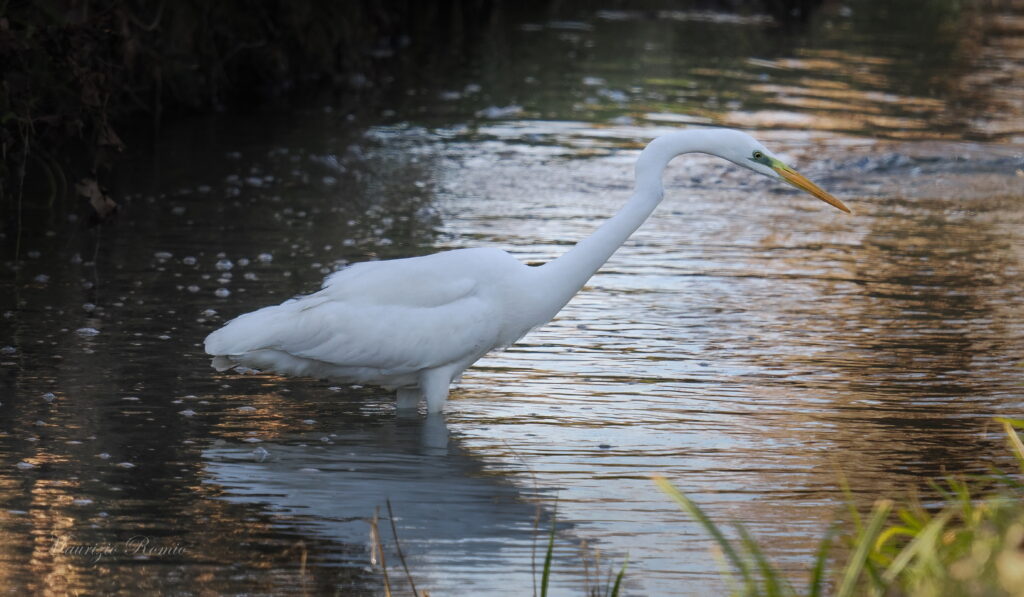
Con rapido tempismo sferra l’attacco.
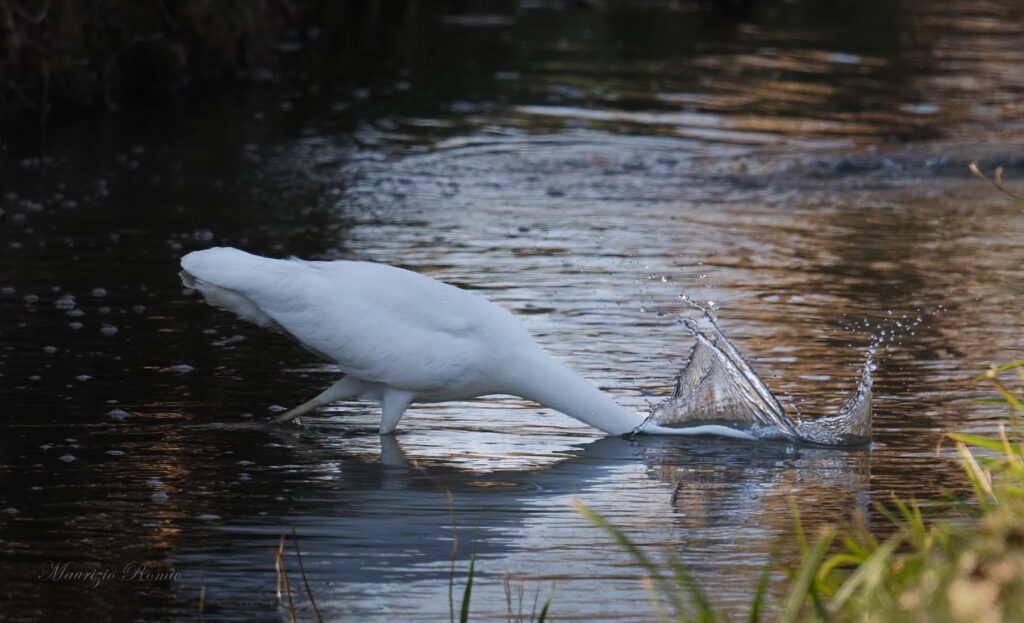
Infila la testa sott’acqua e ricompare con un piccolo pesce trattenuto all’interno del suo becco.
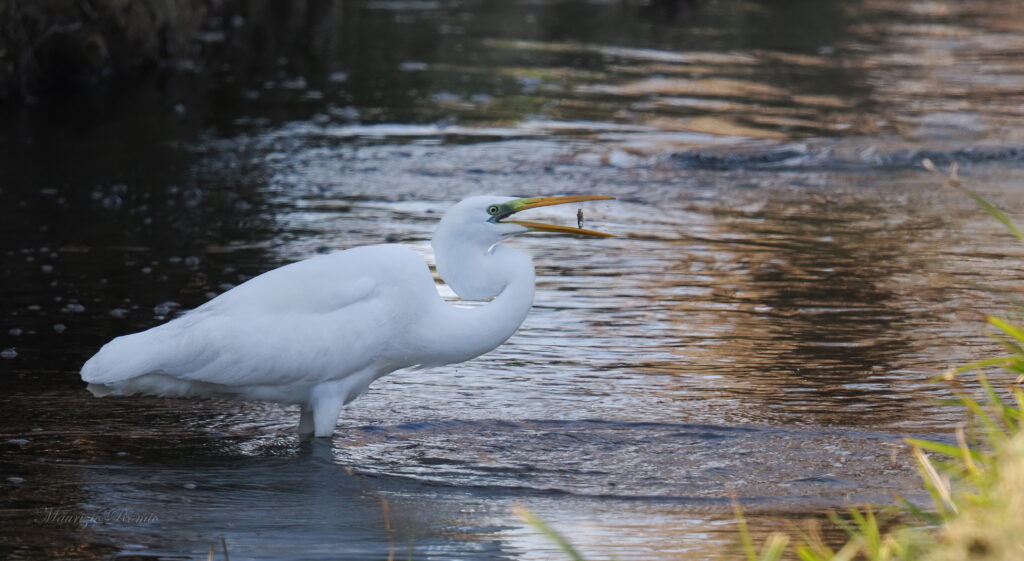
Tra gli uccelli appartenenti alla famiglia degli aironi nella mia zona è invece facile incontrare la garzetta (Egretta garzetta).
Come distinguere un airone bianco maggiore da una garzetta?
Semplice. Oltre che sulle dimensioni, più grande l’airone bianco maggiore rispetto alla garzetta, infatti l’airone bianco maggiore ha una altezza di circa 80-90 cm mentre la garzetta è più piccola, alta circa 50-60 cm, ci si può soffermare ad osservare il colore del loro becco, generalmente giallo nel caso dell’airone bianco maggiore, nero nel caso della garzetta.
Anche il colore dei piedi in queste due specie di uccelli è diverso, abbiamo zampe e piedi neri nel caso dell’airone bianco maggiore, zampe nere ma piedi gialli nel caso della garzetta.
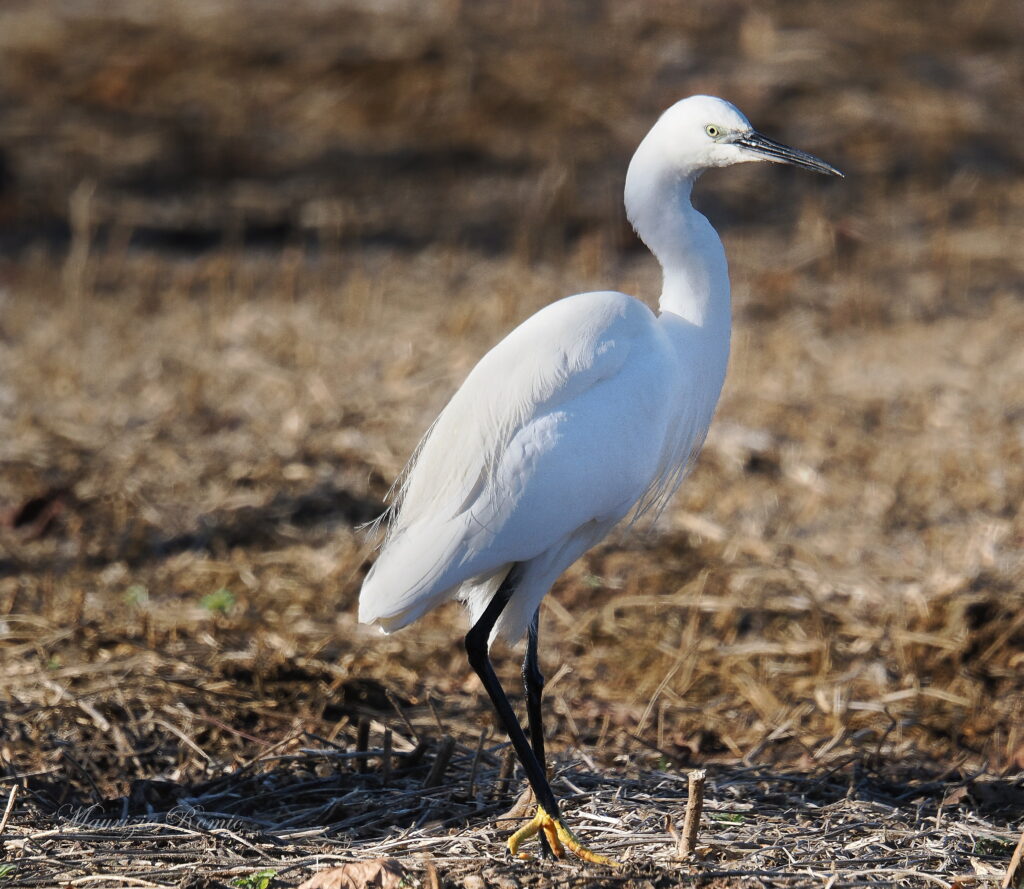
Come ho evidenziato per la ripresa di queste immagini ho utilizzato un corpo macchina e obiettivo della OM System, la OM-1 mark II equipaggiata con il super tele micro quattro terzi OM System M. Zuiko 150-600mm F5.0‑6.3 Sync IS.
Da appassionato di fotografia naturalistica e sportiva questo abbinamento macchina-obiettivo nel mio caso lo trovo ottimo. La stabilizzazione dell’immagine nell’abbinamento funzionale di questi due elementi può raggiungere i 7 stop e ciò mi permette di fotografare i soggetti con una bassa velocità di otturazione dandomi di conseguenza l’opportunità di avere al momento dello scatto un diaframma più chiuso, bassi ISO e una maggiore profondità di campo. Dalla mia breve esperienza all’uso di questo obiettivo super tele 150-600mm mi sembra di rilevare che i migliori risultati dal punto di vista della definizione delle immagini li sto ottenendo con scatti con una apertura di diaframma intorno a f10.
Ho potuto constatare inoltre che anche nel caso di soggetti in movimento l’abbinamento è super…super veloce a mettere a fuoco i soggetti e seguirne i movimenti.
Di seguito alcune fotografie con abbinamento corpo-macchina OM-1 mark II+OM System M. Zuiko 150-600mm e i dati di scatto.
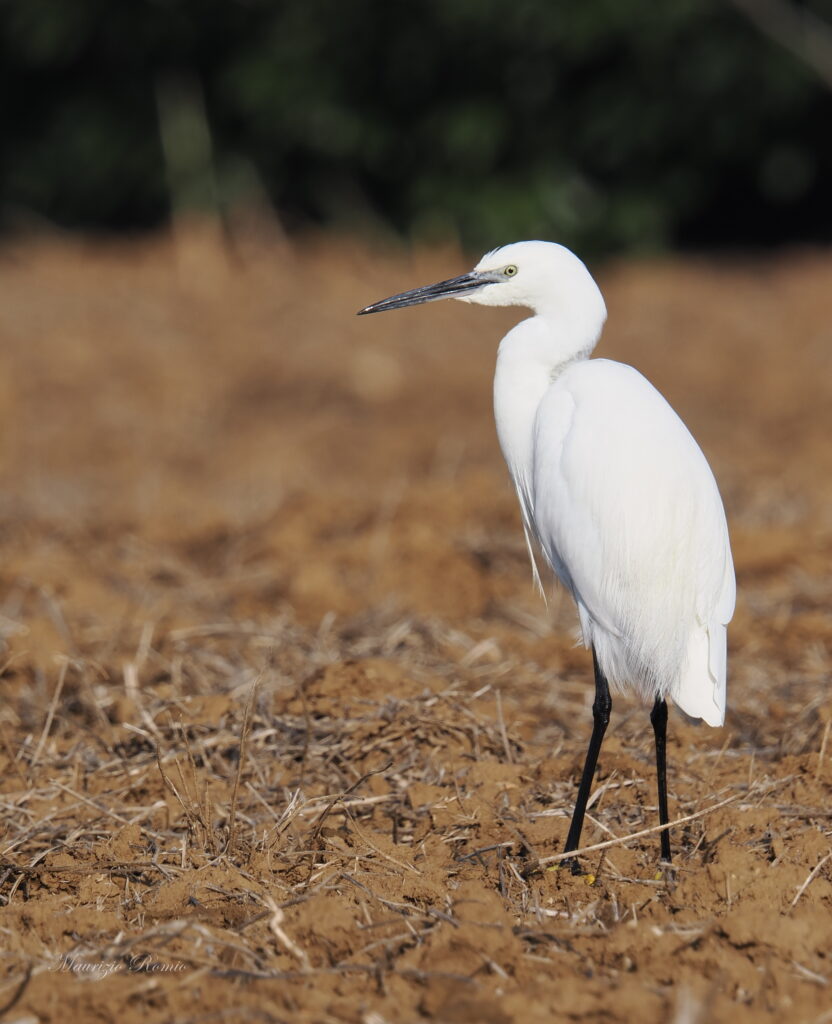
Garzetta (Egretta garzetta). Foto Maurizio Romio. Data scatto: dicembre 2024. Località: Costabissara (VI), Italia. Fotocamera OM System OM-1 mark II + OM System M. Zuiko 150-600mm F5.0‑6.3 Sync IS, 600 mm, efov 1200 mm, 1/400 sec., f10, ISO 200, no tripod, crop.[Little egret – Egretta garzetta – Shot date: December 2024. Location: Costabissara (VI), Italy. OM System OM-1 mark II + OM System M. Zuiko 150-600mm F5.0-6.3 Sync IS camera, 600 mm, efov 1200 mm, 1/400 sec., f10, ISO 200, no tripod, crop]
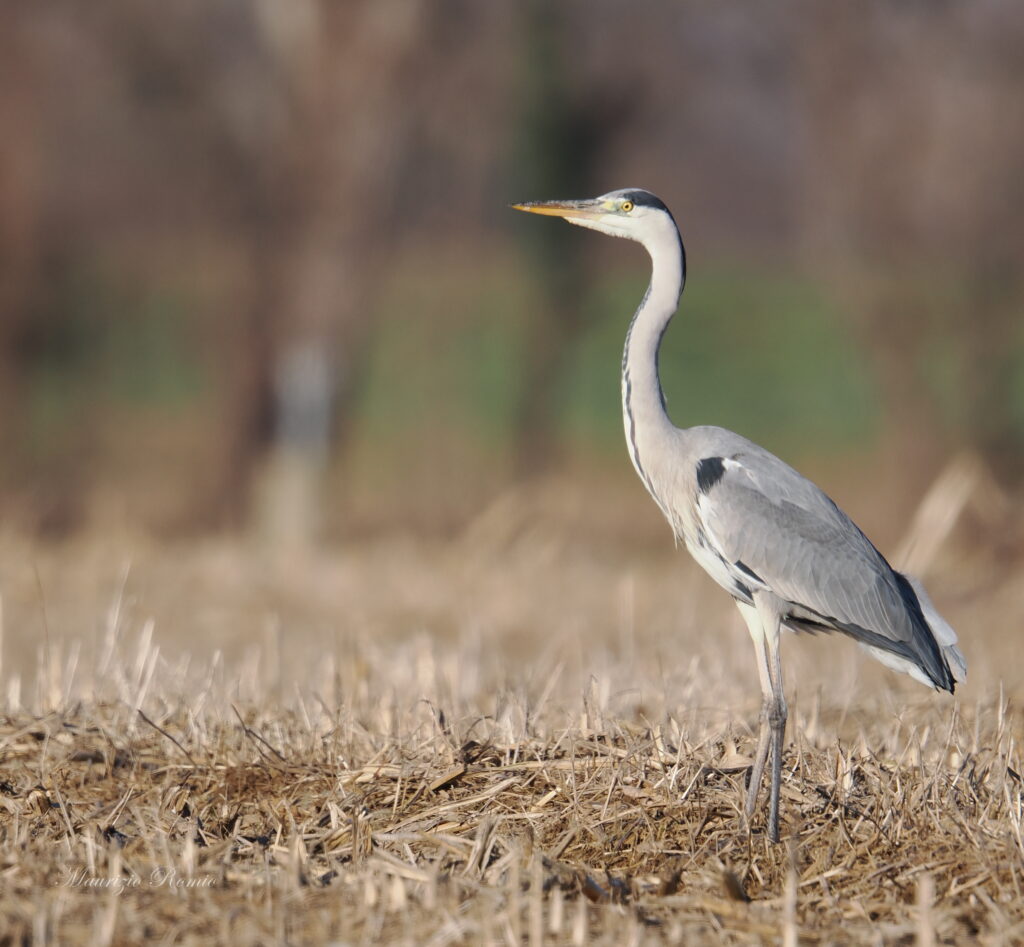
Airone cenerino (Ardea cinerea). Foto Maurizio Romio. Data scatto: dicembre 2024, Località: Costabissara (VI), Italia. Fotocamera OM System OM-1 mark II + OM System M. Zuiko 150-600mm F5.0‑6.3 Sync IS, 600 mm, efov 1200 mm, 1/800 sec., f6.3, ISO 250, no tripod, crop.
Grey Heron (Ardea cinerea). Photo Maurizio Romio. Shooting date: December 2024, Location: Costabissara (VI), Italy. OM System OM-1 mark II + OM System M. Zuiko 150-600mm F5.0-6.3 Sync IS camera, 600 mm, efov 1200 mm, 1/800 sec., f6.3, ISO 250, no tripod, crop.
Great White Egret – Ardea alba
A great white heron (Ardea alba) has chosen to spend the winter in Costabissara
For some time I have been trying to take some still images of a specimen of great white heron (Ardea alba) that I notice stationed along the irrigation ditches and in the fields of my municipality of residence, Costabissara in the province of Vicenza, Italy. About a month ago, in December 2024, I was able to see and photograph it suddenly in the Contarina canal and then I never had the opportunity to see it again. Encountering this bird, especially in my area, is quite rare. There are about 600 nesting pairs of great white herons present in our national territory and the areas near the province of Vicenza where you can see it are the wetlands of the Po Delta, the Venice lagoon, Comacchio and Mezzano.
Generally, the individuals of great white herons that spent winter in Italy come from regions of central Europe and the Balkans, from countries such as Austria and Hungary. Who knows where the specimen I saw came from.
Days ago I was walking along the streets of my town when near a canal located not far from the Orolo stream, I suddenly saw a great white heron intent on “fishing”. The emotion rises… I quickly direct the lens of my camera, an OM system OM-1 mark II equipped with the super telephoto micro four thirds OM System M. Zuiko 150-600mm, towards the heron. The super tele, whose maximum focal length if compared to the 35mm format is equal to 1200mm, allows me to keep a certain distance from the subject during shooting and not let it escape. The heron in front of me continues quietly to probe the bottom of the canal with its paws in search of possible prey. It feeds mainly on amphibians, aquatic invertebrates, fish and small mammals.
Then suddenly I see the heron stop and direct its attention to a precise point in front of it.
With quick timing he launches the attack.
He sticks his head underwater and reappears with a small fish held inside his yellow beak.
Among the birds belonging to the family of the herons in my area it is easy to meet the little egret (Egretta garzetta).
How to distinguish a greater white heron from an egret?
Simple. In addition to the size, the greater white heron is larger than the little egret, in fact the great white heron has a height of about 80-90 cm while the little egret is smaller, about 50-60 cm tall, you can to observe the color of their beak, generally yellow in the case of the great white heron, black in the case of the little egret. The color of the feet in these two species of birds is also different, we have black legs and feet in the case of the great white heron, black legs but yellow feet in the case of the little egret.
As I pointed out, for the shooting of these images I used a camera body and lens from the OM System, the OM-1 mark II equipped with the super telephoto micro four thirds OM System M. Zuiko 150-600mm F5.0-6.3 Sync IS. As a fan of nature and sports photography, I find this camera-lens combination in my case excellent. The image stabilization in the functional combination of these two elements can reach 7 stops and this allows me to photograph subjects with a low shutter speed, consequently giving me the opportunity to have a smaller aperture, low ISO and a greater depth of field at the time of shooting. From my brief experience using this 150-600mm super telephoto lens it seems to me that the best results from the point of view of image definition I am sticking to them with shots with an aperture around f10. I’m also able to see that even in the case of moving subjects the combination is super… super fast to focus on subjects and track their movements.
Altri articoli che ho pubblicato sugli Ardeidi
Una garzetta a pesca: https://www.romio.family/2023/12/27/una-garzetta-a-pesca/
